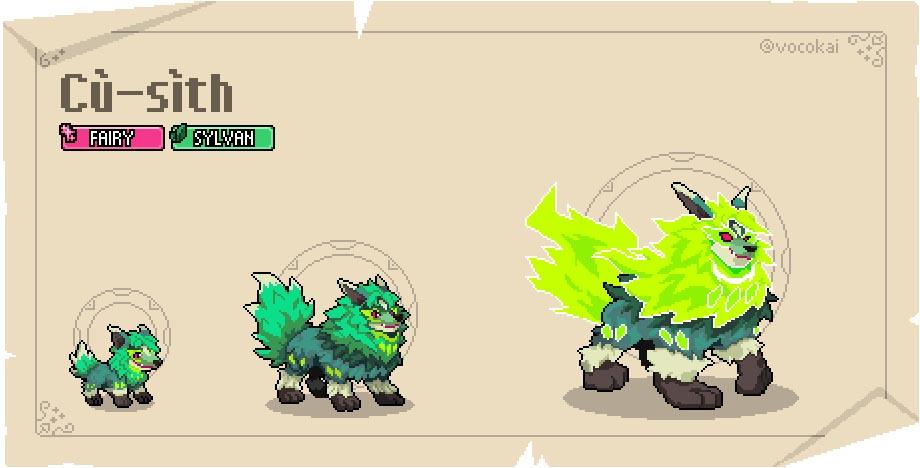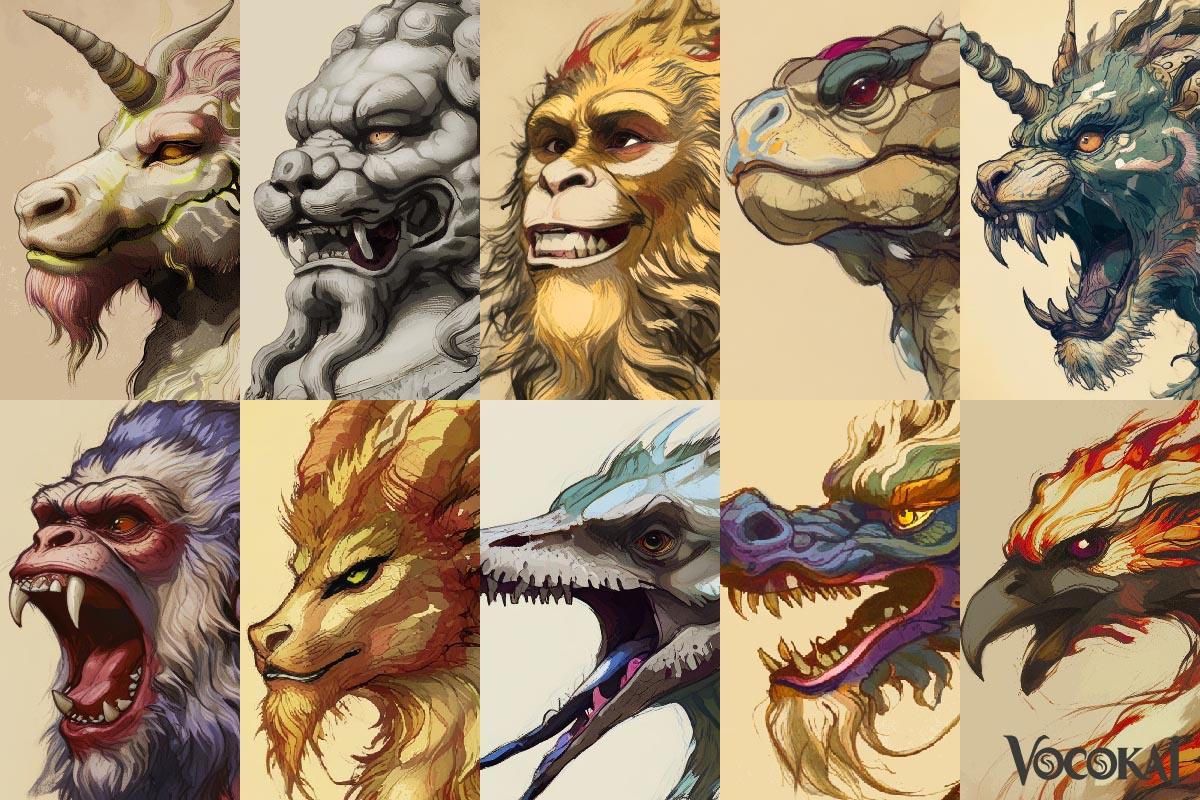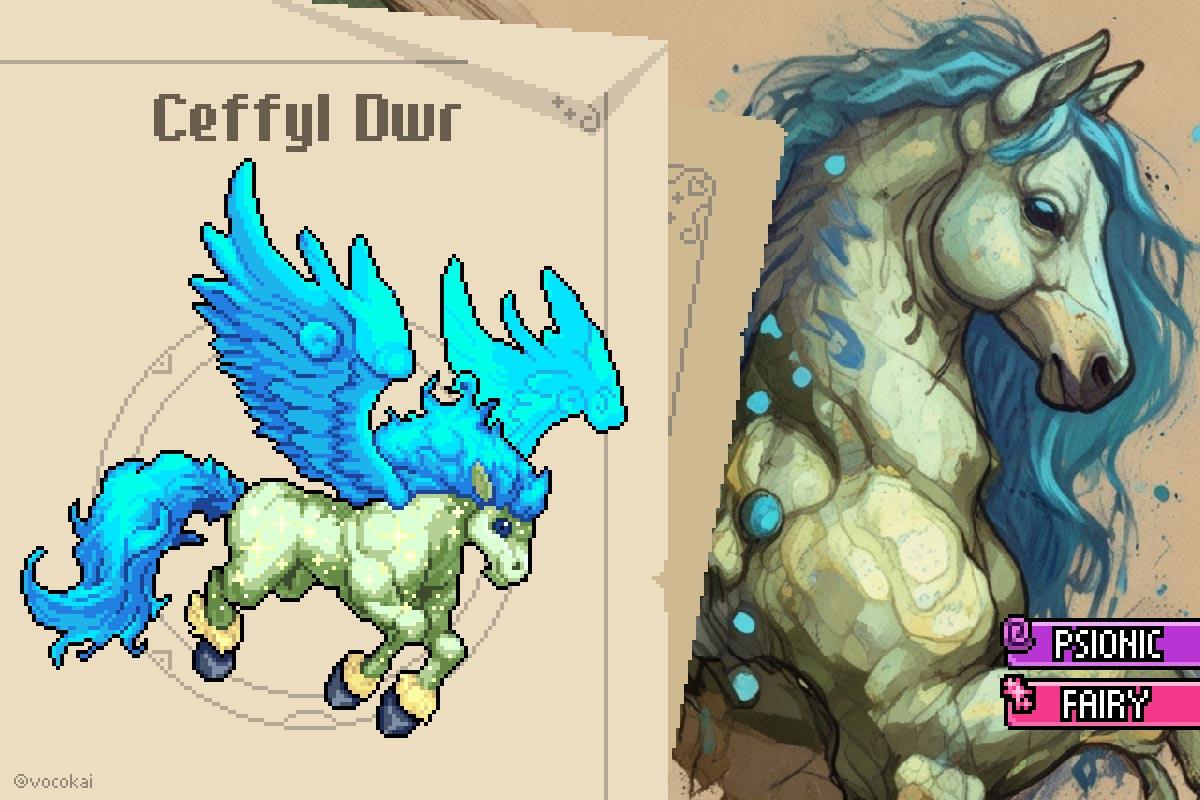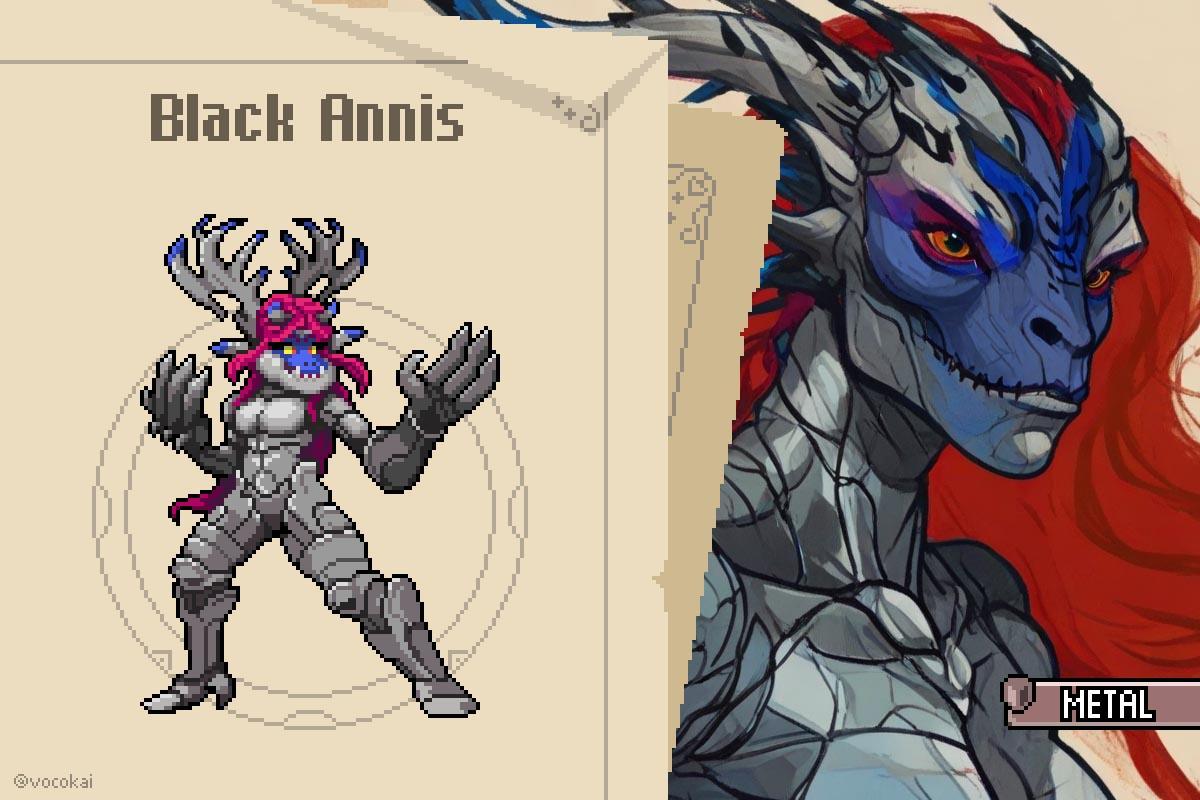Introduction:
The Cù-sìth is a captivating and enigmatic creature from Scottish folklore, often described as a spectral hound with an imposing presence and ghostly appearance. Traditionally associated with the Highlands, this legendary beast is said to roam the misty glens and dark forests, guarding the boundaries of the otherworld. With its striking emerald eyes and distinctive coat, the Cù-sìth embodies the untamed essence of nature and the supernatural.
Legends tell that this haunting hound is both a protector and a harbinger, appearing to those who are destined to face imminent danger. Its mournful howl serves as an eerie warning, signaling the approach of death or misfortune. Like many creatures of folklore, the Cù-sìth encapsulates the duality of beauty and terror, serving as a reminder of the respect owed to the natural world and its unseen forces. In the realm of Scottish myth, the Cù-sìth stands as a symbol of the thin veil between life and death, weaving tales of mystery and caution that continue to resonate in the hearts of those who hear its story.
The Origin and Local Legends
The legend of the Cù-sìth is deeply embedded in Scottish folklore, drawing from the rich tapestry of Celtic mythology where supernatural beings frequently inhabit the landscapes. Often depicted as a large, spectral hound, the Cù-sìth is said to roam the rugged Highlands and remote glens, guarding the boundaries between the living world and the spirit realm. Its name, meaning “dog of the fairy mound,” hints at its connection to the mystical and the unseen.
Descriptions of the Cù-sìth vary across regions, with some accounts portraying it as a fearsome creature with a coat of deep green or black, accentuated by its piercing, luminescent eyes. In various legends, the Cù-sìth serves dual purposes: as a harbinger of death or misfortune, its eerie howl echoes through the hills, warning those who might be near their end, while in other tales, it is a protective spirit, loyal to its chosen companions and guiding them safely through treacherous landscapes.
Local lore often ties the Cù-sìth to specific places, such as ancient burial sites or fairy mounds, enhancing its role as a guardian of sacred grounds. The creature’s mysterious nature resonates with the Scottish belief in the thin veil between life and death, illustrating the complexity of the relationship between humanity and the supernatural. Through these stories, the Cù-sìth embodies the enchanting yet perilous aspects of nature, reminding those who encounter its legend of the respect and caution owed to the forces that lie beyond our understanding.

Haunting Lamentations
The legend of the Cù-sìth reverberates powerfully throughout Scottish folklore, encapsulating a profound emotional duality that intertwines allure and melancholy. Much like the Ceffyl Dŵr of Welsh myth, the Cù-sìth emerges from the misty Highlands, embodying the complex interplay between beauty and danger. Its presence, often heralded by an eerie howl, invokes both awe and trepidation, reflecting the deep-seated respect the Scottish people hold for their natural surroundings.
The Cù-sìth is frequently depicted as a majestic yet fearsome hound, its spectral form haunting the remote glens and ancient burial sites. Unlike the Banshee, whose wails signal impending death, the Cù-sìth serves as both a guardian of the land and a foreboding spirit. In many tales, its mournful cries serve as warnings for those who stray too close to the boundaries between the living and the dead, illustrating the precarious balance between life and mortality.
In various narratives, the Cù-sìth is said to guide lost souls or protect the sacred spaces it roams, while also possessing the power to unleash chaos upon those who disrespect its territory. Its connection to the earth and the spectral realms reflects a deep cultural understanding of the supernatural forces that shape human existence. The haunting lamentations associated with the Cù-sìth echo the community’s shared fears and reverence, resonating with themes of legacy, loss, and the undeniable influence of nature.
This spectral hound, lurking at the fringes of reality, becomes a symbol of the fragility of life and the omnipresent forces of the natural world. The legends of the Cù-sìth serve as poignant reminders of the deep emotional ties between the Scottish people and their landscape, illustrating the need for harmony and respect in the face of the mysteries that lie within.
Regional Variations
The Cù-sìth, much like its counterparts in Celtic folklore, exhibits a rich tapestry of regional variations that reflect the cultural and geographical diversity of Scotland. While the fundamental image of the Cù-sìth as a ghostly hound remains constant, local legends adapt its characteristics and roles to resonate with the specific traditions and landscapes of different communities.
In the mist-laden Highlands, the Cù-sìth is often portrayed as a formidable and ominous creature. It is said to roam the remote glens and desolate moors, its mournful howls echoing through the valleys as a warning to those who venture too far into its territory. Here, the Cù-sìth is regarded with a sense of dread, embodying the fierce power of nature and serving as a harbinger of death. Tales abound of lost travelers lured by the hound’s alluring call, only to meet their doom amidst the treacherous terrain. This portrayal emphasizes the Cù-sìth’s role as both guardian and enforcer, demanding respect for the land and its secrets.
Conversely, in some coastal regions, the Cù-sìth is depicted in a more benevolent light, acting as a protector of seafarers and a guardian of sacred sites. In these stories, the hound assists lost souls or guides fishermen safely back to shore, symbolizing the connection between the spirit world and the living. This dual nature reflects the complex relationship Scottish communities have with the natural environment, highlighting themes of guardianship and respect for the forces of nature.
The variations in the Cù-sìth’s lore parallel other Celtic water spirits, such as the Irish pooka or the Welsh Ceffyl Dŵr, each adapted to their unique regional contexts. While the Cù-sìth may embody foreboding characteristics, its deeper connection to the land and its spirits also illustrates the nurturing aspects of nature. Across Scotland, this spectral hound remains a powerful symbol of the intertwining of the natural and supernatural, capturing the essence of the landscape it inhabits and the mysteries that lie within its shadows.


Shaping Cultural Narratives
The Cù-sìth plays a crucial role in shaping the cultural narratives of Scotland, weaving together themes of nature, mysticism, and the intricate relationship between humanity and the supernatural. This spectral hound transcends its identity as a mere folkloric figure; it embodies the complexities of existence, balancing beauty and danger while influencing artistic, literary, and communal expressions that reflect the deep connection Scottish people have with their rugged landscapes.
In Scottish art, the Cù-sìth is often depicted as a haunting yet majestic figure, its silhouette emerging from the mists of the Highlands or the shadows of ancient woodlands. Artistic representations capture its enigmatic presence, symbolizing both the allure of the wilderness and the hidden dangers it harbors. These portrayals emphasize the respect and reverence that the Scottish have for the natural world, illustrating how the Cù-sìth serves as both guardian and reminder of nature’s unpredictable forces.
Literature and storytelling are rich with narratives centered around the Cù-sìth, often reflecting the unseen influences that shape human fate. Tales of the hound frequently highlight themes of humility and the importance of living in harmony with nature, warning against the hubris of attempting to control forces greater than oneself. Its ghostly nature, appearing and disappearing with the mists, serves as a powerful metaphor for life’s transience and the mysteries of the world that Scottish folklore has long embraced.
The Cù-sìth also plays a significant role in local festivals and cultural traditions, where its legend is passed down through generations, reinforcing the collective identity of Scottish communities. Whether regarded as a protective spirit or a foreboding omen, the Cù-sìth enriches the cultural narrative of Scotland, reminding people of the ongoing interplay between the physical and mystical realms. It remains a potent symbol of the land’s rugged beauty and peril, emphasizing the enduring legacy of folklore in shaping a people’s understanding of their environment and their place within it.
Contemporary Interpretations
Similar to the Ceffyl Dŵr, the Cù-sìth has emerged as a captivating figure in contemporary culture, evolving from a regional Scottish myth into a symbol that resonates with a wider audience. Deeply rooted in Scottish folklore, modern interpretations of the Cù-sìth transcend its original context, appearing across various media and artistic expressions that explore themes of mystery, nature, and the supernatural.
In literature, the Cù-sìth is often reimagined as an emblem of the untamed forces of nature, reflecting humanity’s complex relationship with the environment. Its ethereal yet dangerous nature makes it a compelling character in narratives that delve into ecological themes, portraying the Cù-sìth as a guardian of the wild. These stories, while steeped in ancient tradition, resonate with contemporary concerns about environmental preservation, using the spectral hound as a metaphor for the beauty and peril inherent in nature when disrespected.
In film and television, the Cù-sìth has taken on new roles, frequently blending elements of horror and fantasy. As a shape-shifter and spirit of the Highlands, the creature’s mysterious qualities lend themselves to thrilling visual storytelling, where it may appear as both a protector and a harbinger of doom. These adaptations allow for creative interpretations, presenting the Cù-sìth in scenarios that highlight its spectral nature while engaging with modern storytelling techniques. Whether depicted as a guardian of sacred lands or an unpredictable force that tests the resolve of characters, the Cù-sìth’s mystique continues to captivate audiences.
Beyond fiction, the Cù-sìth remains a prominent figure in contemporary Scottish art and community festivals. Artists draw inspiration from its haunting beauty and duality, often incorporating the Cù-sìth into works that explore the interplay between myth and the natural world. Local festivals celebrate this mythical figure through storytelling, art, and performances, allowing the legend of the Cù-sìth to thrive in a modern context. These events not only honor the creature’s folkloric roots but also serve as a reminder of the significance of cultural heritage in shaping modern identities.
As discussions surrounding environmental awareness, cultural preservation, and the connection between humanity and nature continue to evolve, the Cù-sìth remains a relevant symbol in today’s world. Its transformation from a local legend into a figure that resonates across multiple platforms highlights how folklore can adapt to contemporary concerns while still honoring the timeless themes at its core. Through literature, film, art, and community celebrations, the Cù-sìth continues to inspire and provoke reflection, ensuring that its haunting legacy endures in the modern era.
nd behaviors, particularly in Sussex and the broader English context. As a dragon-like water spirit with a fearsome reputation, the Knucker serves as a cautionary figure for children, warning them of the dangers posed by deep waters and the potential perils of wandering too close to marshy areas. By embodying the frightening aspects of nature, the Knucker encourages children to heed parental warnings and develop a healthy respect for their surroundings. This cautionary role extends beyond mere fear; it fosters awareness of environmental hazards, teaching valuable lessons about safety and the unpredictability of nature. Additionally, the Knucker’s stories contribute to local cultural identity, reinforcing community values that emphasize the importance of vigilance and respect for the natural world.


Appearance
The Cù-sìth possesses a striking and otherworldly appearance, reflecting its enigmatic nature and connection to the mystical landscapes of Scotland. This spectral hound is often described as being larger than an average dog, with a shaggy, dark green or black coat that seems to shimmer with an otherworldly glow, blending seamlessly into the shadows of the Highland glens.
- Phantom Silhouette
- Water-Inspired Features
- Luminous Eyes
- Mysterious Aura
- #
- #
- #
- #
- Phantom Silhouette: The Cù-sìth has a phantom-like silhouette that enhances its ghostly presence. Often depicted as a majestic hound, it can appear both solid and translucent, embodying the duality of the seen and unseen. Its form seems to shift with the mist, at times materializing like a formidable guardian and at others fading into the fog. This ethereal quality mirrors the mysteries of the Scottish Highlands, where the boundaries between the natural and supernatural often blur.
- Water-Inspired Features: While primarily a terrestrial creature, the Cù-sìth’s features evoke the essence of the water it is said to guard. Its coat glistens as if wet, and its movements are fluid and graceful, reminiscent of rippling streams and flowing rivers. Legends sometimes describe its fur as resembling the shadows cast by water, enhancing its connection to the mystical elements of nature. This fluidity highlights the Cù-sìth’s role as a keeper of the wild, embodying both strength and grace.
- Luminous Eyes:A hallmark of the Cù-sìth is its striking eyes, which are often depicted as glowing orbs of green or amber. These luminous eyes pierce through the darkness, capturing the attention of those who dare to venture into its territory. The intensity of its gaze can shift, reflecting its mood—calm and inviting when at rest, or fierce and intimidating when protecting its realm. This enchanting gaze serves as a reminder of the Cù-sìth’s dual nature, capable of both allure and fear.
- Mysterious Aura: The Cù-sìth is surrounded by an enigmatic aura, often accompanied by the soft sounds of the wilderness—the rustling of leaves, the whisper of the wind, or the distant echoes of howls. This haunting atmosphere adds to its spectral quality, creating an unforgettable experience for those who encounter it. The combination of its majestic appearance and the ethereal ambiance it creates ensures that the Cù-sìth remains a powerful symbol of the Scottish landscape, embodying the beauty and peril that coexist within the wild.

Behavior
The Cù-sìth embodies a fascinating interplay of loyalty and mystery, reflecting its deep-rooted connection to the rugged Scottish Highlands. As a spectral hound of Scottish folklore, its behavior is marked by an unpredictable blend of protection and danger, symbolizing the untamed spirit of the natural world.
Elusive and Shapeshifting
Protector of Nature
Despite its potential for danger, the Cù-sìth also acts as a protector of the Highlands and its inhabitants. In many stories, it is portrayed as a guardian spirit of the land, safeguarding sacred sites and ensuring that the balance of nature is maintained. Those who honor the natural world may encounter the Cù-sìth as a benign presence, offering guidance or protection. This duality of nature reflects the complex relationship between humans and their environment, where respect can lead to harmony, while disrespect can invite peril.
Ambiguous Morality
The behavior of the Cù-sìth embodies a rich moral ambiguity, making it challenging to classify as purely good or evil. Its actions are often contingent on the behavior of those it encounters. To those who approach with humility and reverence for the land, the Cù-sìth may merely observe from a distance or provide safe passage through the glens. Conversely, to the arrogant or reckless, it becomes a formidable force, leading them into danger or even to their doom. This moral complexity mirrors the intricate interplay between humanity and the natural world, emphasizing that reverence and respect are essential for coexistence, while hubris can result in dire consequences.
The Influence of the Cù-sìth
Like the Ceffyl Dŵr, the Cù-sìth has significantly impacted contemporary culture, transcending its origins in Scottish folklore to inspire various forms of media, literature, and art. As a spectral hound, the Cù-sìth embodies the duality of awe and caution, offering a rich narrative backdrop for exploring themes of mystery, guardianship, and the supernatural.
Film and Television
The Cù-sìth’s enigmatic nature and haunting presence make it an intriguing subject in fantasy genres, often depicted in stories that explore the mystical qualities of the Highlands:
- “The Outlaw King” (2018): This historical drama touches upon the folklore of Scotland, featuring references to mythical creatures, including spectral dogs. The Cù-sìth’s themes of loyalty and guardianship are echoed in the narrative’s exploration of the bonds between people and their land.
- “Outlander” (2014–present): While primarily focused on historical romance, the series incorporates various elements of Scottish folklore, including references to supernatural creatures. The Cù-sìth fits seamlessly into the show’s rich tapestry of myth and magic, emphasizing the deep connection to the natural and mystical aspects of Scotland.
Literature
The Cù-sìth has long been a prominent figure in Scottish storytelling, with its themes of loyalty, mystery, and the supernatural being explored in both traditional and contemporary literature:
- “The Book of Celtic Folklore” by Thomas Keightly (1867): This collection features tales of the Cù-sìth, preserving its legend and emphasizing its role as a protector of the land. The stories reflect the creature’s significance in the cultural memory of Scotland.
- “The Cù-Sìth” by J.M. Barrie: In this lesser-known work, Barrie explores the themes of childhood and the spectral nature of the Cù-sìth, portraying it as both a friend and guardian to children who wander too far into the wild. This duality highlights the creature’s role in the human psyche, bridging the gap between safety and danger.
Video Games
Video games often draw upon Scottish mythology to create immersive worlds where creatures like the Cù-sìth serve as guardians, allies, or adversaries:
- “Dark Souls III” (2016): This action RPG features various mythical creatures inspired by European folklore, including hounds that share qualities with the Cù-sìth. The game’s atmosphere and narrative evoke the haunting presence of the Cù-sìth, symbolizing both protection and peril in its challenging landscapes.
- “Monster Hunter: World” (2018): While not directly featuring the Cù-sìth, the game includes various mythical creatures from folklore, capturing the essence of the Cù-sìth as a powerful spirit linked to nature. The game’s focus on respecting and coexisting with nature aligns with the themes surrounding the Cù-sìth.
Music and Pop Culture
In modern Scottish and Celtic music, the Cù-sìth continues to inspire artists, reflecting a deep cultural connection to folklore and nature:
- “Cù-sìth” by the Scottish folk band Wolfstone: This evocative song draws on the myth of the spectral hound, capturing the creature’s dual nature and its role as a guardian of the Highlands. The music’s haunting melodies evoke the mystery and allure of the Cù-sìth.
- Celtic Music Festivals: At various festivals celebrating Scottish culture, the Cù-sìth often appears in storytelling sessions and performances, keeping its legend alive for contemporary audiences. These events highlight the creature’s significance in Scottish identity and cultural heritage.
Art and Visual Culture
Artists continue to draw inspiration from the Cù-sìth, using its imagery to explore the relationship between humanity and the natural world. The spectral hound often appears in paintings, sculptures, and digital art, symbolizing the fluid and mysterious nature of life and the hidden forces at play in the wild.
Contemporary Cultural Behavior: The Cù-sìth
The Cù-sìth, a spectral hound from Scottish folklore, continues to cast its shadow over contemporary culture, particularly within Scotland and among enthusiasts of Celtic mythology. This formidable creature embodies the deep connections between nature, the supernatural, and human existence, symbolizing both the awe-inspiring and cautionary aspects of the natural world.

In summary, the Cù-sìth remains a powerful symbol in contemporary culture, reflecting the intricate relationship between humanity and the natural world. Its enduring legacy invites exploration of themes such as respect, protection, and the mystical forces that shape our lives, encouraging a modern audience to engage with the deep-rooted traditions of Scottish folklore.

















